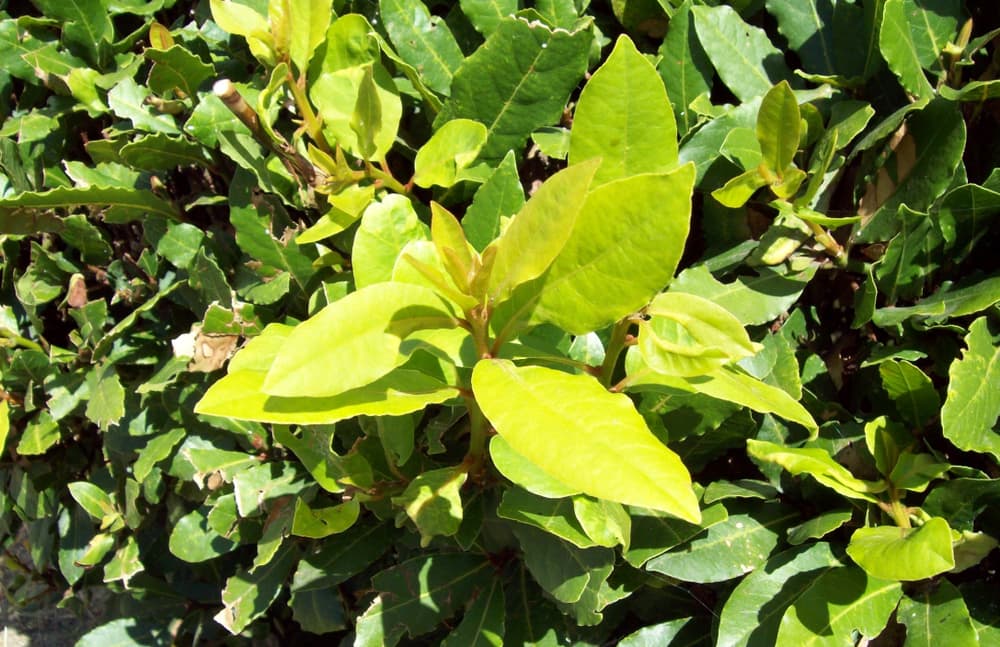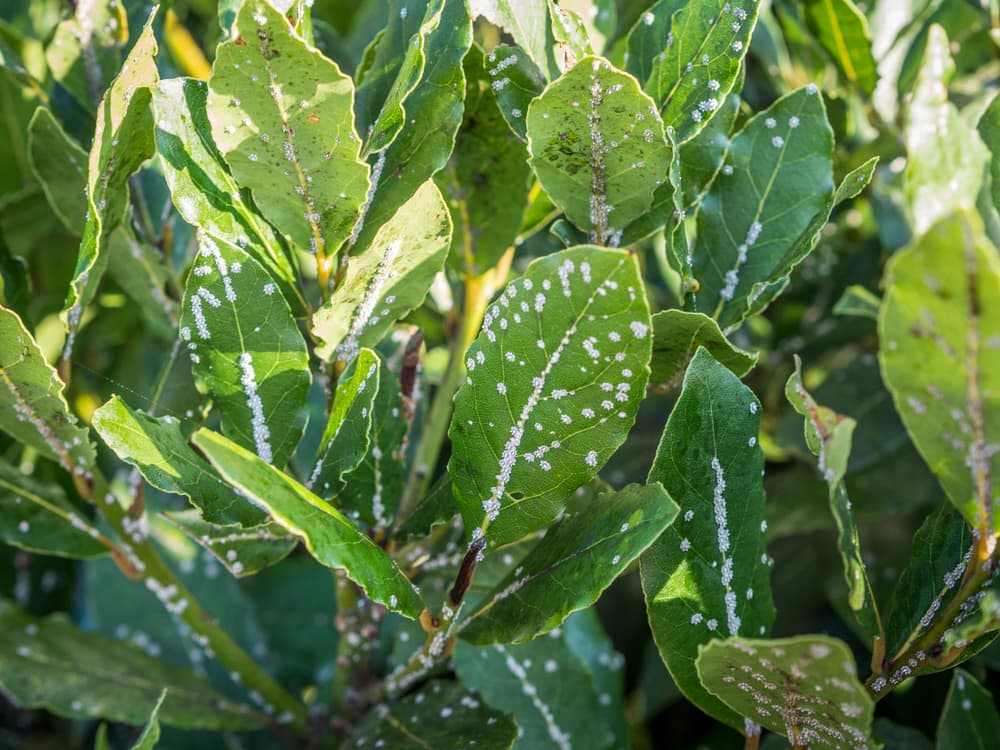TREES > BAY
Chris is a gardening writer and nature enthusiast. He graduated from Oxford Brookes University in 2022 with an MA in Psychology. Chris works with the Leeds Green Action Society, helping their food cooperative by growing various fruit and vegetables on their two allotments in Hyde Park, Leeds.
Reviewed By PETER LICKORISH

Peter is a Horticulture Lecturer and self-employed Horticulturist, with a passion for diverse areas of the industry - from garden design to the science behind plant growth and propagation. He has completed the Royal Horticultural Society’s Master of Horticulture (MHort) Award and lectures on RHS courses at Bedford College.
IN THIS GUIDE
BAY GUIDES
The bay tree, or Laurus nobilis, is an elegant evergreen shrub grown for its deliciously aromatic leaves that can be used as a seasoning in cooking.
Although bay trees can grow as high as 7.5m or more, they are often pruned or kept in containers or pots to limit their height and spread.
Bay trees are slow-growing and have become a popular ornamental tree, often used for formal displays
Their gorgeously dark green foliage can be easily pruned, clipped and trained into neat topiary shapes.

Being evergreen, bay trees provide year-round interest, texture and structure to the garden.
They also produce small, star-shaped, yellow-green flowers which bloom in spring which develop into dark purple berries in autumn.
Overview
| Botanical Name | Laurus nobilis |
| Common Name(s) | Bay Tree |
| Plant Type | Tree |
| Native Area | Mediterranean |
| Hardiness Rating | H4 |
| Foliage | Evergreen, leathery aromatic leaves |
| Flowers | Inconspicuous, green |
| When To Sow Or Plant | March, April, September, October, November |
| When To Prune | January, February, December |
Sunlight
Preferred Sunlight
Full Sun / Partial Shade
Exposure
Exposed or Sheltered
Size
Height
8 – 12M
Spread
8M+
Soil
Preferred Soil Type
Chalk, loam, sand, clay
Moisture
Well drained
pH
Any
Easily recognisable by their fragrant, smooth, glabrous leaves, bay trees are evergreen trees or shrubs which are part of the flowering plant family of Lauraceae.1S. (n.d.-e). Sweet Bay. Wisconsin Horticulture. Retrieved March 13, 2023, from https://hort.extension.wisc.edu/articles/sweet-bay-laurus-nobilis/
Bay trees are native to the Mediterranean regions and can be used either fresh or dried in cooking.2Laurus nobilis. (n.d.). Kew Royal Botanic Gardens. Retrieved March 13, 2023, from https://powo.science.kew.org/taxon/urn:lsid:ipni.org:names:465049-1
Why Grow Bay?
The bay trees glossy leaves have been treasured for centuries and are now a firm favourite among gardeners.
But, if you aren’t yet sold on this popular plant then allow us to break down exactly why we love them!
Cuisine
Bay leaves have a spicy, peppery, aromatic flavour and are commonly used in curries, soups and stews.
It is also an essential ingredient in the herb mix ‘Bouquet Garni’.

The leaves can be used fresh, or you can harvest them and summer and dry them.
Dried bay leaves have a much more robust flavour but should be stored for no more than a year.
Pest Resistance
The plant itself is highly resistant to pests so can be used as a companion plant to help protect other plants from infestation.
Dried bay leaves are also said to help to protect stored grains and beans and other foods from weevils.
Privacy
Because of the ease in which they can be clipped and trained, bay trees can be grown as a screen or a hedge to provide privacy and a shield from the elements.
It is slow-growing, however, so patience is a virtue with this practical plant.
Bay Tree Varieties
There are only a few types of bay tree to choose from, which means narrowing down the right one for you is a piece of cake.
Laurus nobilis

This large, erect evergreen shrub is the bay tree most commonly cultivated, and its leathery leaves are used in cooking for its aromatic flavouring.
The Laurus nobilis, or species bay tree, can grow up to 12m in height and over 8m in spread, but is slow-growing and can take up to 50 years to reach its full stature.
It is traditionally clipped and trained into beautiful, ornamental topiary, providing sophisticated structure to formal gardens. It can also be used to create a hedge or screen, providing privacy to your garden.
Because it is easily grown in pots and containers, it is a perfect addition to a garden of any size and can be grown both inside and out.
L. nobilis ‘Aurea’

The L. nobilis ‘Aurea’, commonly known as ‘Golden Bay’, is a large evergreen shrub or, eventually, a small tree, growing to a maximum height of 8m.
It sports attractive golden leaves which are particularly useful for providing winter colour, and these leaves can also be used in cooking.
Growing in a broad, conical habit, this type of bay tree can also be trimmed and trained into stylish shapes and can also form smaller hedges.
Like the L. nobilis, the golden bay can be grown either in the ground or in large pots or containers.
L. nobilis ‘Angustifolia’

L. nobilis ‘Angustifolia’ is a rare shrub with slender, willow-like leaves which can also be used in cooking.
Commonly known as a narrow-leaved bay tree, this species can also be clipped creatively into a work of art and grows well both in the ground and large containers.
This variety is smaller and can reach an eventual height of around 6m and 5m in width, sometimes taller, although, as with the others, don’t hold your breath as this can take up to 50 years.
How To Grow A Bay Tree
Bay trees are wonderfully versatile and can be grown inside or out and in the ground or in containers.
Planting Out
If planting in the garden, choose a sheltered spot with well-drained soil, in full sun or partial shade.
You can ready the soil by digging in compost and grit.

If you are planting bay for formal structure, ensure that the young tree is standing straight to achieve the best aesthetic.
Once planted, water well and continue to water regularly for a couple of weeks to help your bay establish itself.
Container Growing
If you are growing your bay in a container, then be sure to use tree and shrub compost, which usually contains loam for stability, and water well in summer when it is more likely to dry out.
When growing bay trees inside, position it by a sunny window, avoiding exposure to drafts and heated appliances.
Bay Tree Plant Care
Bay trees are generally problem-free and easy to maintain; the most complex care comes if you are training it as topiary.
Pruning
Bay trees should be pruned in summer with secateurs, and old plants can be cut back hard in late spring to give them a new lease of life.

Be patient with older plants as it can take them a while to get their vitality back, so you can prune them over two years by cutting half the stems back one year and the other half the following year.
Top tip: If you are trying to train your bay tree as a topiary specimen for the first time, we highly recommend purchasing a topiary frame. This will help you sculpt your bay tree into your desired shape. For the best results, regularly prune through the growing season.
Common Problems
Bay trees are relatively trouble-free, but there are a few things to keep an eye out for.
“Likely pests include bay suckers, which are psyllid insects, and scale insects, which cling tightly to stems,” shares Peter Lickorish, Master Horticulturist.
“Pyrethrum can be used to treat sap suckers this, or nature can be used to solve your problems if you encourage ladybirds, using bug hotels, to predate pests.”

In addition to pests, Peter notes how the climate can sometimes cause some problems for these trees:
“Bay trees have suffered from the cold winter 2022-23 in the UK, with many showing browned leaves.
“When dealing with frost damage, wait until active growth resumes and frosts are easing, around May, and prune out affected leaves, cutting back to the next healthy foliage.
“Avoiding planting trees in positions facing east can prevent damage from rapid thawing after frosts.
“Potassium, often found in fertilisers marketed for tomatoes, can act like anti-freeze and prevent some frost damage.”
Harvesting Bay Leaves
Bay leaves can be harvested throughout the growing season; however, if you wish to harvest a larger quantity, we recommend doing so in midsummer when the leaves are at their peak and have the fullest flavour.
You can use the bay leaves fresh, or if you wish to dry them, place them on a baking sheet, spaced apart, so they aren’t touching and cover with a layer of paper towels.
Place the leaves in a warm, dry location, out of direct sunlight.
After a week, flip the leaves and leave them to dry for another week and voila! – your dried bay leaves are ready to go.

No matter what size your garden is, there is always room for a bay tree, and they are an excellent choice for beginners hoping to hone their topiary skills.
Whether they grow in the garden, or in pots, outside or inside, bay trees will reward you, year after year, with their beauty and deliciously flavourful leaves.
References
- 1S. (n.d.-e). Sweet Bay. Wisconsin Horticulture. Retrieved March 13, 2023, from https://hort.extension.wisc.edu/articles/sweet-bay-laurus-nobilis/
- 2Laurus nobilis. (n.d.). Kew Royal Botanic Gardens. Retrieved March 13, 2023, from https://powo.science.kew.org/taxon/urn:lsid:ipni.org:names:465049-1

